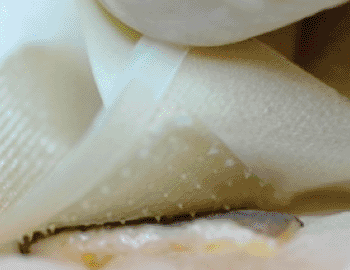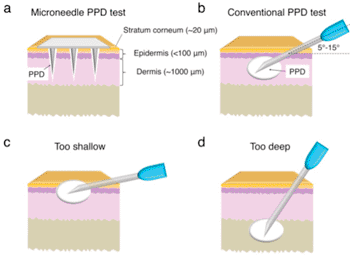Biodegradable Microneedle Patch Automates Tuberculosis Skin Testing
By LabMedica International staff writers
Posted on 04 Sep 2013
A patch comprising biodegradable microneedles has been developed that may replace the classical hypodermic needle tuberculin diagnostic test for tuberculosis.Posted on 04 Sep 2013
The standard diagnostic test for tuberculosis (termed the Mantoux technique) is based on an intradermal injection of tuberculin, which is a species-nonspecific glycerol extract of the tubercle bacillus obtained from filtrates of sterilized, concentrated cultures. A person who has been exposed to tuberculosis bacteria is expected to mount an immune response in the skin containing the bacterial proteins. The reaction is read by measuring the diameter of induration (palpable raised, hardened area) across the forearm (perpendicular to the long axis) in millimeters.
However, the standard diagnostic test is difficult to perform, since obtaining a correct diagnosis depends on the hypodermic needle being inserted into the arm of the patient at a precise angle and depth.
Investigators at the University of Washington (Seattle, USA) recently reported development of a technique that promises to be a significant improvement to the Mantoux technique. They created a patch containing biodegradable chitin microneedles. Each needle is 750 micrometers long and is coated with tuberculin solution.
The patch test was evaluated on guinea pigs, and results showed that following insertion of the microneedles, the positive skin reaction associated with having a tuberculosis infection was identical to that obtained when using the standard hypodermic needle test.
"It is like putting on a bandage," said senior author Dr. Marco Rolandi, assistant professor of materials science and engineering at the University of Washington. "As long as the patch is applied on the skin, the test is always delivered to the same depth underneath the skin. With a microneedle test there is little room for user error, because the depth of delivery is determined by the microneedle length rather than the needle-insertion angle. This test is painless and easier to administer than the traditional skin test with a hypodermic needle."
The guinea pig study was published in the August 26, 2013, online edition of the journal Advanced Healthcare Materials.
Related Links:
University of Washington






 assay.jpg)








